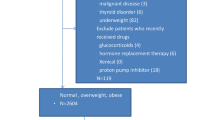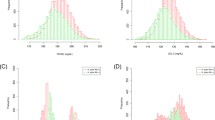Abstract
Background and Aim
Helicobacter pylori (H. pylori) infection causes extra-gastrointestinal as well as gastric diseases. This analytical cross-sectional study was performed to investigate the association between H. pylori infection and metabolic syndrome in a Korean population.
Methods
Anthropometric and metabolic data, as well as anti-H. pylori IgG antibodies, were measured in 21,106 subjects who participated in a health checkup between January 2016 and June 2017. The classification of metabolic syndrome followed the revised National Cholesterol Education Program criteria.
Results
After excluding subjects with a history of H. pylori eradication therapy, or gastric symptoms, the seropositivity of H. pylori was 43.2% in 15,195 subjects. H. pylori-positive participants had significantly higher body mass index (BMI), waist circumference, total cholesterol (TC), low-density lipoprotein cholesterol (LDL-C), and lower high-density lipoprotein (HDL-C) than did seronegative participants (P < 0.05). After adjusting for confounders, high TC, low HDL-C, and high LDL-C were associated with H. pylori seropositivity. Finally, the prevalence of metabolic syndrome was higher in H. pylori-seropositive subjects than in negative ones (27.2% vs. 21.0%, P < 0.05), and H. pylori seropositivity increased the likelihood of metabolic syndrome (OR 1.19, 95% CI 1.09–1.31, P < 0.001) after adjusting for sex, age, BMI, smoking, residence, household income, and education level. However, the association between H. pylori seropositivity and metabolic syndrome disappeared in those ≥ 65 years old.
Conclusions
H. pylori infection plays an independent role in the pathogenesis of metabolic syndrome in Koreans under 65 years old.

Similar content being viewed by others
Abbreviations
- H. pylori :
-
Helicobacter pylori
- HP :
-
Helicobacter pylori
- MS:
-
Metabolic syndrome
- TC:
-
Total cholesterol
- WC:
-
Waist circumference
- WHO:
-
World Health Organization
- BMI:
-
Body mass index
- BP:
-
Blood pressure
- TG:
-
Triglycerides
- LDL-C:
-
Low-density lipoprotein cholesterol
- HDL-C:
-
High-density lipoprotein cholesterol
- FG:
-
Fasting glucose
- Anti-HP IgG:
-
Helicobacter pylori immunoglobulin G antibody
- NCEP:
-
National Cholesterol Education Program
- OR:
-
Odds ratio
- CI:
-
Confidence interval
- IR:
-
Insulin resistance
References
McColl KE. Clinical practice. Helicobacter pylori infection. N Engl J Med. 2010;362:1597–1604.
de Korwin JD, Ianiro G, Gibiino G, Gasbarrini A. Helicobacter pylori infection and extra gastric diseases in 2017. Helicobacter. 2017;22:e12411.
Lim JH, Kim N, Lim SH, Kwon JW, et al. Inverse relationship between Helicobacter pylori infection and asthma among adults younger than 40 years: a cross-sectional study. Medicine (Baltimore). 2016;95:e2609.
Lim SH, Kim N, Kwon JW, Kim SE, et al. Trends in the seroprevalence of Helicobacter pylori infection and its putative eradication rate over 18 years in Korea: a cross-sectional nationwide multicenter study. PLoS One. 2018;13:e0204762.
Watanabe S, Hojo M, Nagahara A. Metabolic syndrome and gastrointestinal diseases. J Gastroenterol. 2007;42:267–274.
Jinjuvadia R, Antaki F, Lohia P, Liangpunsakul S. The association between nonalcoholic fatty liver disease and metabolic abnormalities in the United States population. J Clin Gastroenterol. 2017;51:160–166.
Mozumdar A, Liguori G. Persistent increase of prevalence of metabolic syndrome among US adults: NHANES III to NHANES 1999–2006. Diabetes Care. 2011;34:216–219.
Nestel P, Lyu R, Low LP, Sheu WH, et al. Metabolic syndrome: recent prevalence in East and Southeast Asian populations. Asia Pac J Clin Nutr. 2007;16:362–367.
Lim S, Shin H, Song JH, Kwak SH, et al. Increasing prevalence of metabolic syndrome in Korea: the Korean national health and nutrition examination survey for 1998–2007. Diabetes Care. 2011;34:1323–1328.
Oh SW. Obesity and metabolic syndrome in Korea. Diabetes Metab J. 2011;35:561–566.
Tran BT, Jeong BY, Oh JK. The prevalence trend of metabolic syndrome and its components and risk factors in Korean adults: results from the Korean National Health and nutrition examination survey 2008–2013. BMC Public Health. 2017;17:71.
Lee SE, Han K, Kang YM, Kim S-O, et al. Trends in the prevalence of metabolic syndrome and its components in South Korea: findings from the Korean National Health Insurance Service Database (2009–2013). PLoS ONE. 2018;13:e0194490.
Gunji T, Matsuhashi N, Sato H, Fujibayashi K, et al. Helicobacter pylori infection is significantly associated with metabolic syndrome in the Japanese population. Am J Gastroenterol. 2008;103:3005–3010.
Chen LW, Chien CY, Yang KJ, Kuo SF, Chen CH, Chien RN. Helicobacter pylori Infection increases insulin resistance and metabolic syndrome in residents younger than 50 years old: a community-based study. PLoS ONE. 2015;10:e0128671.
Naja F, Nasreddine L, Hwalla N, Moghames P, et al. Association of H. pylori infection with insulin resistance and metabolic syndrome among Lebanese adults. Helicobacter. 2012;17:444–451.
Takeoka A, Tayama J, Yamasaki H, Kobayashi M, et al. Impact of Helicobacter pylori immunoglobulin G levels and atrophic gastritis status on risk of metabolic syndrome. PLoS ONE. 2016;11:e0166588.
Lim SH, Kwon JW, Kim N, Kim GH, et al. Prevalence and risk factors of Helicobacter pylori infection in Korea: nationwide multicenter study over 13 years. BMC Gastroenterol. 2013;13:104.
Kim SY, Ahn JS, Ha YJ, Doh HJ, et al. Serodiagnosis of Helicobacter pylori infection in Korean patients using enzyme-linked immunosorbent assay. J Immunoassay. 1998;19:251–270.
Kim JH, Kim HY, Kim N, Kim SW, et al. Seroepidemiological study of Helicobacter pylori infection in asymptomatic people in South Korea. J Gastroenterol Hepatol. 2001;16:969–975.
Yim JY, Kim N, Choi SH, Kim YS, et al. Seroprevalence of Helicobacter pylori in South Korea. Helicobacter. 2007;12:333–340.
Kim N. Part III Diagnosis 8. Serology In: Kim N, editor. Helicobacter pylori. Singapore: Springer; 2016:113–118.
van Der Ende A, van Der Hulst RWM, Roorda P, Tytgat GNJ, Dankert J. Evaluation of three commercial serological tests with different methodologies to assess Helicobacter pylori infection. J Clin Microbiol. 1999;37:4150–4152.
Grundy SM, Cleeman JI, Daniels SR, Donato KA, et al. Diagnosis and management of the metabolic syndrome: an American Heart Association/National Heart, Lung, and Blood Institute Scientific Statement. Circulation. 2005;112:2735–2752.
World Health Organization. Regional Office for the Western Pacific. The Asia-Pacific perspective: redefining obesity and its treatment. Sydney: Health Communications Australia. 2000:15–21. http://www.who.int/iris/handle/10665/206936. Accessed January 05, 2018.
Sung KC, Rhee EJ, Ryu SH, Beck SH. Prevalence of Helicobacter pylori infection and its association with cardiovascular risk factors in Korean adults. Int J Cardiol. 2005;102:411–417.
Nam SY, Ryu KH, Park BJ, Park S. Effects of Helicobacter pylori infection and its eradication on lipid profiles and cardiovascular diseases. Helicobacter. 2015;20:125–132.
Kim TJ, Lee H, Kang M, Kim JE, et al. Helicobacter pylori is associated with dyslipidemia but not with other risk factors of cardiovascular disease. Sci Rep. 2016;6:38015.
Wald NJ, Law MR, Morris JK, Bagnall AM. Helicobacter pylori infection and mortality from ischaemic heart disease: negative result from a large, prospective study. BMJ. 1997;315:1199–1201.
Niemelä S, Karttunen T, Korhonen T, Läärä E, et al. Could Helicobacter pylori infection increase the risk of coronary heart disease by modifying serum lipid concentrations? Heart. 1996;75:573–575.
Chen TP, Hung HF, Chen MK, Lai HH, et al. Helicobacter pylori infection is positively associated with metabolic syndrome in Taiwanese adults: a cross-sectional study. Helicobacter. 2015;20:184–191.
Shin DW, Kwon HT, Kang JM, Park JH, et al. Association between metabolic syndrome and Helicobacter pylori infection diagnosed by histologic status and serological status. J Clin Gastroenterol. 2012;46:840–845.
Polyzos SA, Kountouras J, Zavos C, Deretzi G. The association between Helicobacter pylori infection and insulin resistance: a systematic review. Helicobacter. 2011;16:79–88.
Upala S, Jaruvongvanich V, Riangwiwat T, Jaruvongvanich S, Sanguankeo A. Association between Helicobacter pylori infection and metabolic syndrome: a systematic review and meta-analysis. J Dig Dis. 2016;17:433–440. https://doi.org/10.1111/1751-2980.12367.
Park MJ, Choi SH, Kim D, Kang SJ, et al. Association between Helicobacter pylori seropositivity and the coronary artery calcium score in a screening population. Gut Liver. 2011;5:321–327.
Gallin JI, Kaye D, O’Leary WM. Serum lipids in infection. N Engl J Med. 1969;281:1081–1086.
Feingold KR, Grunfeld C. Role of cytokines in inducing hyperlipidemia. Diabetes. 1992;41:97–101.
Memon RA, Grunfeld C, Moser AH, Feingold KR. Tumor necrosis factor mediates the effects of endotoxin on cholesterol and triglyceride metabolism in mice. Endocrinology. 1993;132:2246–2253.
Migneco A, Ojetti V, Specchia L, Franceschi F, et al. Eradication of Helicobacter pylori infection improves blood pressure values in patients affected by hypertension. Helicobacter. 2003;8:585–589.
Gobert AP, Mersey BD, Cheng Y, Blumberg D, Newton JC, Wilson KT. Cutting edge: urease release by Helicobacter pylori stimulates macrophage inducible nitric oxide synthase. J Immunol. 2002;168:6002–6006.
Cammarota G, Figura N, Cianci R, Pasceri V, et al. Is there an antigenic mimicry between arteriosclerotic lesions and H. pylori antigens? Clin Biochem. 2000;33:419–421.
Zhou X, Liu W, Gu M, Zhou H, Zhang G. Helicobacter pylori infection causes hepatic insulin resistance by the c-Jun/miR-203/SOCS3 signaling pathway. J Gastroenterol. 2015;50:1027–1040.
Wellen KE, Hotamisligil GS. Inflammation, stress, and diabetes. J Clin Invest. 2005;115:1111–1119.
Gillum RF. Infection with Helicobacter pylori, coronary heart disease, cardiovascular risk factors, and systemic inflammation: the Third National Health and Nutrition Examination Survey. J Natl Med Assoc. 2004;96:1470–1476.
Nabipour I, Vahdat K, Jafari SM, Pazoki R, Sanjdideh Z. The association of metabolic syndrome and Chlamydia pneumoniae, Helicobacter pylori, cytomegalovirus, and herpes simplex virus type 1: the Persian Gulf Healthy Heart Study. Cardiovasc Diabetol. 2006;5:25.
Malamug LR, Karnchanasorn R, Samoa R, Chiu KC. The role of Helicobacter pylori seropositivity in insulin sensitivity, beta cell function, and abnormal glucose tolerance. Scientifica (Cairo). 2014;2014:870165.
Gerig R, Ernst B, Wilms B, Thurnheer M, Schultes B. Gastric Helicobacter pylori infection is associated with adverse metabolic traits in severely obese subjects. Obesity (Silver Spring). 2013;21:535–537.
Lee JH, Kim N, Chung JI, Kang KP, et al. Long-term follow up of Helicobacter pylori IgG serology after eradication and reinfection rate of H. pylori in South Korea. Helicobacter. 2008;13:288–294.
Acknowledgments
This work was supported by a Grant (No. 2011-0030001) of the National Research Foundation (NRF) for the Global Core Research Center (GCRC) funded by the Ministry of Science, ICT and Future Planning (MSIP), Republic of Korea.
Author information
Authors and Affiliations
Contributions
SHL collected and analyzed the data and drafted the article. NK designed and supervised this study and edited this manuscript. JWK provided statistical support and helped to provide the table and figures. NK, SHL, SEK, GHP, JYL, KSP, JES, HJS, DSM, SCC, HJK and JHL helped to collect the data and edited the manuscript. JYY and JSK reviewed the manuscript. All authors have read and approved the final draft of this manuscript.
Corresponding author
Ethics declarations
Conflict of interest
All authors declare that they have no conflict of interest.
Ethical approval
All procedures performed in studies involving human participants were in accordance with the ethical standards of the institutional and/or national research committee, the 1964 Declaration of Helsinki, and its later amendments or comparable ethical standards.
Informed consent
Informed consent was obtained from all participants in this study.
Additional information
Publisher's Note
Springer Nature remains neutral with regard to jurisdictional claims in published maps and institutional affiliations.
Rights and permissions
About this article
Cite this article
Lim, S.H., Kim, N., Kwon, J.W. et al. Positive Association Between Helicobacter pylori Infection and Metabolic Syndrome in a Korean Population: A Multicenter Nationwide Study. Dig Dis Sci 64, 2219–2230 (2019). https://doi.org/10.1007/s10620-019-05544-3
Received:
Accepted:
Published:
Issue Date:
DOI: https://doi.org/10.1007/s10620-019-05544-3




